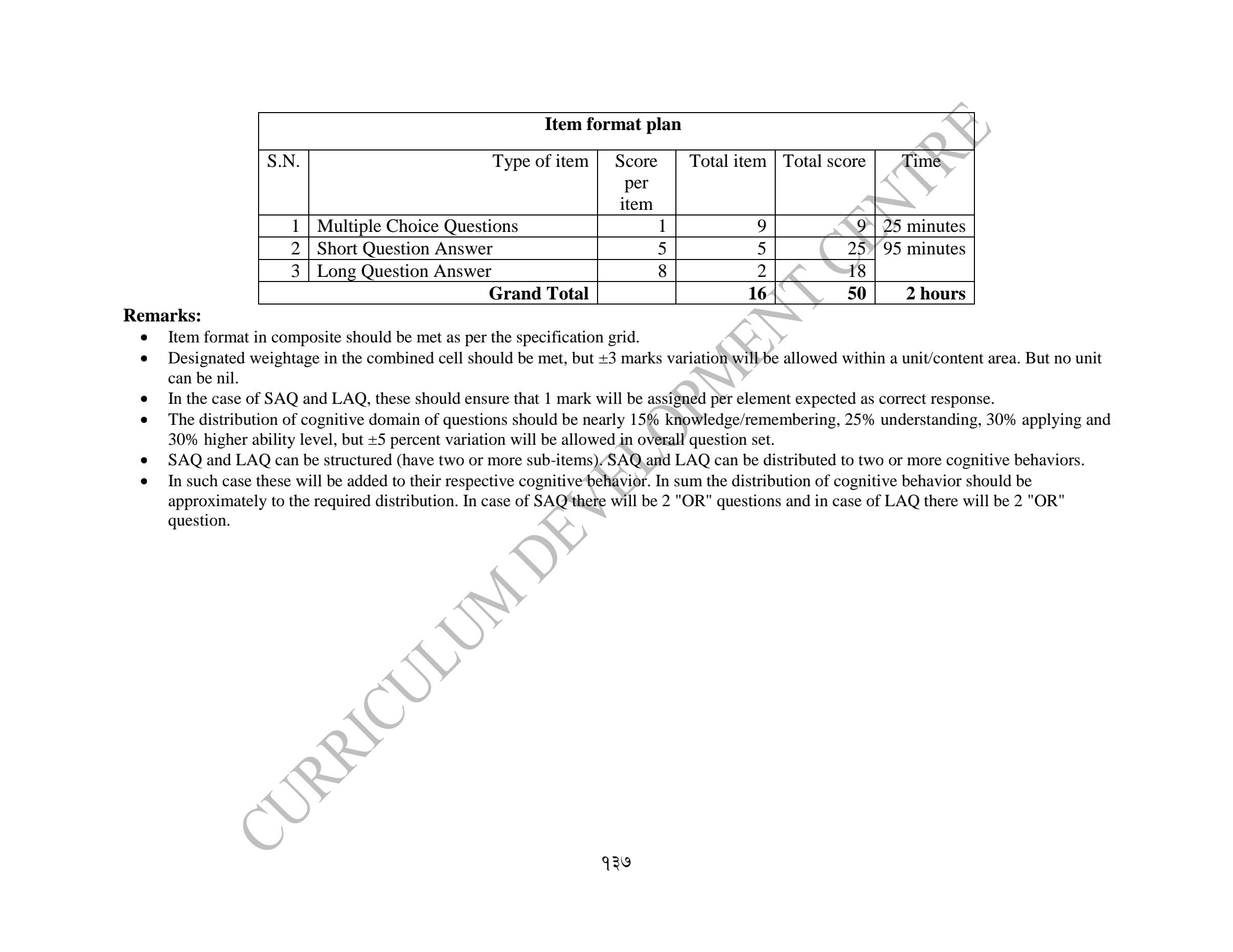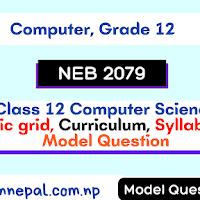Class 12 Computer Science specific grid, curriculum, syllabus, and model question for the Nepal Examination Board (NEB) board exam in 2081 - 2081. In this post, we will provide students with all the necessary information they need to succeed in their Class 12 Computer Science Exams.
Table of Contents
Syllabus: Class 12 Computer Science
Class 12 Computer Science syllabus covers a wide range of topics including Database Management Systems (DBMS), Network and Data Communication, Web Technology II (CSS, JavaScript, PHP), C Programming II, Object-Oriented Programming (OOP) concepts, Software Process Models, and recent trends in Information and Communication Technology (ICT).
Students will learn about advanced programming concepts, web development, and the latest technologies in the field.
The syllabus is designed to provide students with a solid foundation in computer science and prepare them for further studies or careers in the field.
NEB Computer Science Syllabus for Class 12, 2081 and 2082 is given as:
CHAPTER 1: DATABASE MANAGEMENT SYSTEM (DBMS)
- 1.1 Introduction to data, database, Database system, DBMS
- 1.2 Field, Record, Objects, Primary Key, Alternate key, Candidate key
- 1.3 Advantages of using DBMS
- 1.4 DDL (Data Definition Language) and DML (Data Manipulation Language)
- 1.5 Database Model: Network Model, Hierarchical Model, Relational database model
- 1.6 Concept of Normalization: 1NF, 2NF, 3NF
- 1.7 Centralized Vs. Distributed Database
- 1.8 Database Security
CHAPTER 2: DATA COMMUNICATION AND NETWORKING
- 2.1 Basic elements of Communication System:
- 2.2 Concept of Communication System
- 2.3 Block Diagram of Communication System /Model
- 2.4 Elements of Data Communication/Transmission
- 2.5 Simplex, Half duplex, and Full duplex communication mode
- 2.6 Concept of LAN and WAN
- 2.7 Transmission Medium: Guided and Unguided
- 2.8 Transmission impairments terminology (Jitter, Singing, Echo, Crosstalk, Distortion, Noise, Bandwidth, Number of receivers)
CHAPTER 3: WEB TECHNOLOGY II
- 3.1 Introduction
- 3.2 Server side and Client Side Scripting
- 3.3 Introduction to internet technology
- 3.4 Adding Javascript to HTML page
- 3.5 Java script fundamental
- 3.6 Java Script Data types
- 3.7 Variables and operators
- 3.8 Functions and control structure if-else, if-else- if, switch-case, for, while, do while loop
- 3.9 Object-based programming with JavaScript and Event handling
- 3.10 Image, event, and form objects
- 3.11 Form validation, JQuery
- 3.12 Server-Side Scripting using PHP
- 3.13 Introduction to PHP: Hardware and Software Requirements
- 3.14 Object-oriented programming with server-side scripting
- 3.15 Basic PHP syntax
- 3.16 PHP data types
- 3.17 Basic Programming in PHP
- 3.18 Operators (Arithmetic, logical, comparison, operator precedence)
- 3.19 Variables Manipulation
- 3.20 Database Connectivity
- 3.21 Connecting server-side script to database
- 3.22 Making SQL queries
- 3.23 Fetching data sets getting data about data
- 3.24 Creating SQL database with server-side scripting
- 3.25 Displaying queries in tables
CHAPTER 4: PROGRAMMING IN C
- 4.1 Review of C programming concept
- 4.2 Functions
- 4.2.1 Concept of library and user-defined functions and advantages
- 4.2.2 function definition, prototype, call and return statements
- 4.2.3 Accessing a Function by passing values
- 4.2.4 Concept of storage: automatic and external
- 4.2.5 Concept of Recursion: factorial and Fibonacci problems
- 4.3 Structures and Unions
- 4.3.1 Structure: Definition, Declaration, Initialization, and Size of Structure.
- 4.3.2 Accessing Members of the structure
- 4.3.3 Array of structure
- 4.3.4 Union: Definition, Declaration
- 4.3.5 Difference between union and structure.
- 4.4 Pointers
- 4.4.1 Definition of Pointer
- 4.4.2 Address (&) and indirection (*) operator
- 4.4.3 Pointer Expression and Assignment
- 4.4.4 Call by values and call by reference
- 4.5 Working with Files
- 4.5.1 Concept of Data File
- 4.5.2 Sequential and Random File
- 4.5.3 File manipulation function: putw, getw, putc, getc, fscanf, fprintf
- 4.5.4 Opening, Reading, Writing, and Appending data file
CHAPTER 5: OBJECT-ORIENTED PROGRAMMING (OOP)
- 5.1 Programming paradigms: procedural, structural, and object-oriented
- 5.2 Features of OOP: Class, Object, Polymorphism, and Inheritance
- 5.3 Advantages of OOP
- 5.4 Application of OOP
CHAPTER 6: SOFTWARE PROCESS MODEL (SPM)
- 6.1 Software Project Concept
- 6.2 Concept of the software development process
- 6.3 Concept SDLC life cycle
- 6.4 System Analyst Vs Software Engineer
- 6.5 Requirement Collection Methods
- 6.6 Concept of system design
- 6.7 Software and quality
- 6.8 Software development model: waterfall, prototype, agile
CHAPTER 7: RECENT TRENDS IN TECHNOLOGY
- 7.1 Concept of Artificial Intelligence(AI)and Robotics
- 7.2 Concept of Cloud Computing
- 7.3 Concept of Big Data
- 7.4 Concept of Virtual Reality
- 7.5 Concept of e-com, e-medicine, e-gov.
- 7.6 Concept of Mobile Computing
- 7.7 Concept of Internet of things(IoT)
Specification Grid: Class 12 Computer Science
The National Examination Board (NEB) has published a new specification grid for Class 12 Computer Science, dividing the model questions into three groups: Group A with 9 objective multiple choice questions (1 mark each, 25 minutes), Group B with 5 short answer questions (5 marks each, 45 minutes), and Group C with 2 long questions (8 marks each, 50 minutes) for a total exam time of 2 hours.
| Group | Item | Question | Weigh | Total Marks | Time |
| A | Multiple choice questions | 9 | 1 | 9 | 25 minutes |
| B | Short answer question | 5 | 5 | 25 | 95 minutes |
| C | Long answer question | 2 | 8 | 16 |
Related Posts
Model Question: Class 12 Computer Science
The Latest Model question for Class 12 Computer Science as per the new NEB curriculum is divided into three groups: Groups A, B, and C.
Group A contains 9 multiple choice questions, each carrying 1 mark, and the total mark for this group is 9. The questions are based on the concepts of SQL, network topology, JavaScript, and web technology.
Group B contains 5 short answer questions, each carrying 5 marks, and the total marks for this group is 25. The questions are based on the concepts of Database Management Systems, programming, and web technologies.
Group C contains 2 long answer questions, each carrying 8 marks, and the total marks for this group is 16. The questions are based on the concepts of IP addressing, array manipulation, and programming.
Group ‘A’ (9 x 1 = 9)
Multiple Choice Questions. Tick the correct answer.
- Which of the statements are used in DDL?
- A) Create, alter and drop
- B) Create, insert and select
- C) Insert, update, and delete
- D) Delete, alter and drop.
- With SQL, how do you select all the records from a table named “Persons” where the value of the column “FirstName” ends with an “a”?
- A) SELECT * FROM Persons WHERE FirstName=’a’
- B) SELECT * FROM Persons WHERE FirstName LIKE ‘a%’
- C) SELECT * FROM Persons WHERE FirstName LIKE ‘%a’
- D) SELECT * FROM Persons WHERE FirstName=’%a%’.
- Which of the following statements is true about a star network topology?
- A) Each device is connected to a switch or hub
- B) Each device is connected to the other
- C) Each device is connected to a trunk
- D) Each device is connected to a terminal.
- Which of the following is the correct syntax to display “Stay Safe” in an alert box using JavaScript?
- A) alert-box(“Stay Safe”);
- B) confirm(“Stay Safe”);
- C) msgbox(“Stay Safe”);
- D) alert(“Stay Safe”);
- What is the use of<A> tag?
- A) To insert an image
- B) To create a link
- C) To create a hyperlink
- D) To create a list.
- What is the output of a given C program?
- A) FIRST FIRST 0 0
- B) FIRST FIRST 1 1
- C) FIRST FIRST 1 0
- D) FIRST FIRST 0 1
- Where is a class derived in inheritance?
- A) Superclass
- B) Subclass
- C) Subsetclass
- D) Relative class.
- Which of these is the correct order of the SDLC?
- A) Analysis, Design, Coding, Testing, Implementation
- B) Analysis, Design, Testing, Implementation, Coding
- C) Implementation, Coding, Analysis, Design, Testing
- D) Design, Testing, Implementation, Coding, and Analysis.
- Why is cloud computing popular nowadays?
- A) Cost-sharing and easily accessible
- B) As modern technology and costly
- C) Accessible and freely available
- D) Affordable to all.
void main(){
char str1[] = "FIRST"; char str2[20]; strcpy(str2,str1);
printf("%s %s ",str1,str2); printf("%d", (str1!=str2));
printf("%d", strcmp(str1,str2)); }Group ‘B’
Short Answer Questions (5 x 5 = 25)
OR
Demonstrate the basic DML statement with an example.
2. Write a function to add any two numbers in Javascript.
OR
3. Describe any five features of OOPs.
4. What are the different stages of software planning?
Group ‘C’
Long Answer Questions (2 x 8 = 16)
OR
Write a program to read the marks of any 5 students in a subject and count how many students pass and fail.
Related Posts
Every morning you have two choices: continue to sleep with your dreams, or wake up and chase them.




